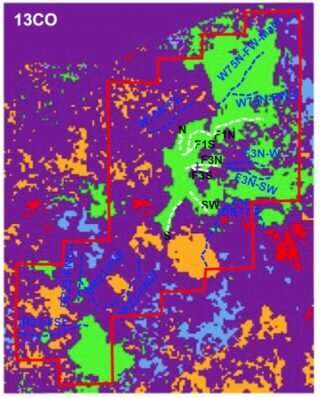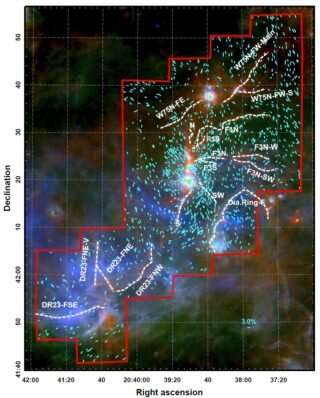Lasagna or spaghetti? Magnetic fields and star-formation

While staring at a multi-colored image of four overlapping clouds in the constellation Cygnus, a northern constellation on the plane of the Milky Way, Astronomy Professor Dan Clemens thought he saw a bowl of tri-colored spaghetti.
Clemens and his team were studying the origins of massive protostars—stars that will eventually shine brighter than a thousand Suns—hidden behind a dark band of clouds and dust, but first they needed to know whether the clouds around them were colliding or interacting. He realized there could be answers in pasta forms.
"We wanted to see whether the clouds were in different layers, like flat noodles in lasagna—with the layers appearing to overlap on the sky, but in reality located far, far apart along the line of sight—or whether the clouds were made of tangled filaments, like spaghetti," Clemens said. "Which pasta is in front of which pasta? Are there separate piles of pasta, or are they interacting piles of pasta that cause stars to form? If the clouds are well-separated from each other along the line of sight, with no interactions among the clouds, then the lasagna model is best. But if multiple clouds or filaments are jumbled together and possibly interacting or colliding, then spaghetti is the right pasta model."

To test for layering, Clemens' team measured cloud distances using observations and measurements from Boston University's Perkins Telescope Observatory (PTO) in Northern Arizona; the Stratospheric Observatory for Infrared Astronomy (SOFIA), a joint project of NASA and the German Space Agency; and the European Space Agency's Gaia satellite. They also looked at Japanese radio maps.
Gaia provides distances to many stars, and the NIR data tells us whether a star is in front of or behind a gas cloud. To locate the distance of each cloud, the BU team looked for jumps in the NIR polarization, which comes from cloud dust grains interacting with magnetic fields; as well as reddening of the Gaia stars, as starlight passing through clouds grows fainter and redder as some light is absorbed or scattered by the dust grains.
The results, which Clemens presented at a poster session at the American Astronomical Society meeting on Monday, June 13, show that the star-forming region of Cygnus is dominated by one massive gas cloud—5,500 light years away—and that other, less-massive clouds are located closer to us—4,700, 3,300, and 2,400 light years distance—and thus are not likely involved in the current round of star formation. The clouds are separated by large distances—800 light years is the smallest separation—while on the sky the clouds span only 30 to 80 light years.

Now that the team knows that the clouds are separated, Clemens said, they can turn the SOFIA equipment towards the star forming region without worry of signals from other clouds, and continue to explore how the massive protostars in Cygnus were made.
"The clouds are well-separated and in distinct layers," Clemens says. "So, lasagna is the right answer, though with lots of ricotta cheese between the layers. This means we can now isolate where each cloud forms stars, what the magnetic field properties are, and whether the spaghetti filaments employ magnetic fields to transport material to the star forming sites."
Provided by Boston University





















